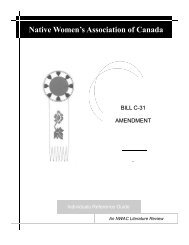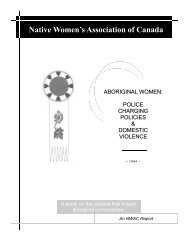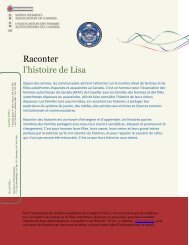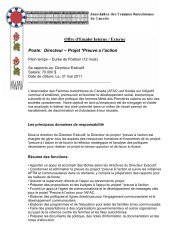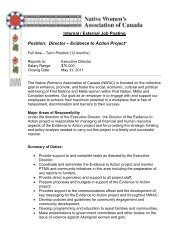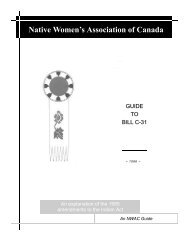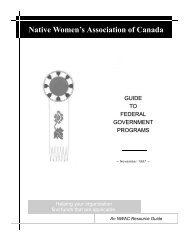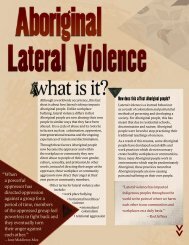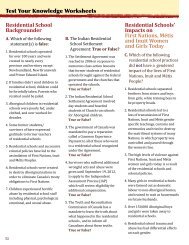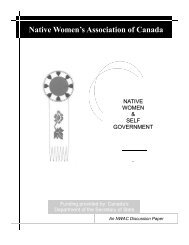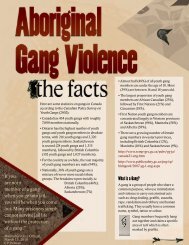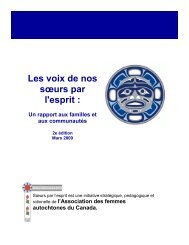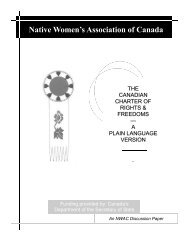BILL C-31 - Native Women's Association of Canada Website
BILL C-31 - Native Women's Association of Canada Website
BILL C-31 - Native Women's Association of Canada Website
- No tags were found...
You also want an ePaper? Increase the reach of your titles
YUMPU automatically turns print PDFs into web optimized ePapers that Google loves.
<strong>Native</strong> Women’s <strong>Association</strong> <strong>of</strong> <strong>Canada</strong><strong>BILL</strong> C-<strong>31</strong>:UNITYFOR OURGRANDCHILDREN~ March 23-25, 1998 ~1 st National Conference onBill C-<strong>31</strong> held in Ottawa, OntarioAn NWAC Report
Table <strong>of</strong> ContentsExecutive Summary ...................................................................... <strong>31</strong>. <strong>Native</strong> Women <strong>of</strong> <strong>Canada</strong>'s Litigation Background............... 5a) Bill C-<strong>31</strong>- Indian Act Amendment..................................................5b) Bill C-<strong>31</strong>: Unity for our Grandchildren Conference .......................62. Day 1: Proceedings............................................................... 7a) Guest Speaker Presentations.......................................................7b) Section 6(2) ..................................................................................9c) Participant Stories.......................................................................10d) Legal Panel Presentations..........................................................123. Day 2: Proceedings............................................................. 14a) Workshop 1: Impediments to Inequality......................................15b) Workshop 2: Residual Discrimination Relating to Bill C-<strong>31</strong> ........17c) Workshop 3: National and International Rights Implications ......184. Day 3: Proceedings and Recommendations....................... 195. Conclusion .......................................................................... 20Pg. 2
<strong>BILL</strong> C-<strong>31</strong>: UNITY FOR OUR GRANDCHILDRENCONFERENCE PROCEEDINGSExecutive SummaryIn March 1998 the <strong>Native</strong> <strong>Women's</strong> <strong>Association</strong> <strong>of</strong> <strong>Canada</strong> hosted a conference on theimpact <strong>of</strong> Bill C-<strong>31</strong> since its inception 13 years ago. The intent <strong>of</strong> the conference was tobring delegates together families to discuss how their lives have been affected.The conference drew 170 delegates from across <strong>Canada</strong>. Speakers and facilitatorswere chosen from all areas. The overall feelings <strong>of</strong> the delegates to the conference wasthat Bill C-<strong>31</strong> has created many more divisions than was previously found in First Nationcommunities and families. Many applauded the Bill because it gave Indian status backto their women and children. But at the same time they condemned the federalgovernment for allowing First Nations to develop strict and rigid band membershipcodes that blocked many women and their children former returning to their homecommunities.Although the implementation and interpretation <strong>of</strong> Bill C-<strong>31</strong> has divided First Nationcommunities and families, there appears to be one common unifying thread. It was feltthat Section 6(2) <strong>of</strong> the revised Indian Act serve no other purpose than to furtheradvance assimilation into mainstream society and reduce the status Indian population.There was general agreement that Section 6(2) <strong>of</strong> the Indian Act which barred thesecond generation from gaining status or restricted their marriage choice must beeliminated.Many participants expressed the hurt that they have experienced when they attemptedto go home to their communities. They are labeled as "Bill C-<strong>31</strong>" and "Paper Indians"even today. This points to the fact that there is still a great deal <strong>of</strong> misinformation andlack <strong>of</strong> communication.Out <strong>of</strong> this conference, two main resolutions were passed that will provide a futureaction plan for the NWAC. Other recommendations can be found on page 25 <strong>of</strong> thisreport.Pg. 3
Resolution # 1: United NationsWhereas we have inherent rights as defined by <strong>Canada</strong>'s Indigenous people, andunder treaties and rights under the Canadian Charter <strong>of</strong> Rights and Freedoms,the Constitution Acts and International law,Be it resolved that the <strong>Native</strong> <strong>Women's</strong> <strong>Association</strong> <strong>of</strong> <strong>Canada</strong> immediately taketo the United Nations and other international communities or tribunals, theresidual discrimination in Sections 6(2) and 11 <strong>of</strong> the Indian Act as introduced byBill C-<strong>31</strong>, which led to the extinguishment <strong>of</strong> the rights <strong>of</strong> our grandchildren and<strong>of</strong> our communities, and also draw international attention to the need to amendthe Indian Act so as to remove the discriminatory effects <strong>of</strong> Bill C-<strong>31</strong>.Passed by ConsensusResolution # 2: Follow Up ConferenceBe it resolved that the NWAC host a follow-up conference on Bill C-<strong>31</strong> to be heldin September 1998.Passed by ConsensusPg. 4
1. <strong>Native</strong> Women <strong>of</strong> <strong>Canada</strong>'s Litigation BackgroundIn March, 1992, NWAC and two <strong>of</strong> its executive members, Gail Stacey-Moore andSharon McIvor, brought proceedings in the Federal Court - Trial Division (reported as<strong>Native</strong> <strong>Women's</strong> <strong>Association</strong> <strong>of</strong> <strong>Canada</strong> et al. v. <strong>Canada</strong> (1992), 53 F.T.R. 194)challenging the Government <strong>of</strong> <strong>Canada</strong>'s decision not to fund NWAC's participation inthe constitutional renewal process then underway. NWAC argued that the governmentdeprived Aboriginal women <strong>of</strong> their equality rights, guaranteed under the Charter, byrefusing to provide funding commensurate with that provided to the Aboriginal groupswhich were invited to the consultations. On August 20, 1992, a unanimous panel <strong>of</strong> theFederal Court <strong>of</strong> Appeal rendered judgment in favour <strong>of</strong> NWAC (reported at [1992] 3F.C. 192), finding that the voice <strong>of</strong> Aboriginal women had been unconstitutionallysilenced in the consultation processes by virtue <strong>of</strong> the lack <strong>of</strong> funding provided toNWAC.In this case, NWAC was described by Mr. Justice Mahoney, speaking for the Court, asfollows:The evidence establishes that it is a grassroots Organization founded and led byaboriginal women...Among its objectives is to be the national voice for native Women, to advancetheir issues and concerns and to assist. And promote common goals towardnative self-determination. The record is replete with evidence <strong>of</strong> NWAC'sactivities in pursuit <strong>of</strong> those objectives including the publication <strong>of</strong> reports andposition papers and appearances before judicial inquiries and Parliamentarycommittees. NWAC is a bonafide, established and recognized national voices <strong>of</strong>and for Aboriginal women. (p.199-200).The Supreme Court <strong>of</strong> <strong>Canada</strong>, by judgment released October 27,1994, (reported at11994] 3 S.C.R. 627), allowed an appeal from the decision <strong>of</strong> the Federal Court <strong>of</strong>Appeal brought by Her Majesty the Queen, and dismissed NWAC's application. TheCourt did not find that NWAC’s exclusion from the consultations had infringed thecharter, but the Court's majority decision, written by Sopinka J., did not challengeNWAC's standing to bring the case to the Federal Court on behalf <strong>of</strong> Aboriginal women.Sopinka J, referred to NWAC's at the beginning <strong>of</strong> his reasons as “a group representingthe interests <strong>of</strong> Aboriginal women” [p.633]. Later in his reasons he states that “I wish tostress that nothing stated in these reasons is intended to detract in any way from anycontention by or on behalf <strong>of</strong> Aboriginal women that they face racial and sexualdiscrimination which impose serious hurdles to their equality” [p.664].a) Bill C-<strong>31</strong>: Indian Act AmendmentAn Act to Amend the Indian Act (S.C.-1985, C. 27), commonly referred to as Bill C-<strong>31</strong>,was passed in April 15, 1985 to coincide with the coming into force <strong>of</strong> s. 15 <strong>of</strong> theCharter <strong>of</strong> Rights and Freedoms, to restore band membership to thousands <strong>of</strong> womenPg. 5
and council before 1958. She felt that the introduction <strong>of</strong> a band council within theGitksan people broke down the hereditary Chief system and almost destroyed it. In theDelgamuuk case the people went with their oral history with evidence to back theirclaim. The ruling was that oral history had to be considered while before it was not. Thishas set a precedence across the country and the Gitksan people hope it will assist FirstNation peoples in their struggles.Joan Holmes gave an overview <strong>of</strong> Bill C-<strong>31</strong>. She stated that she was hired to write apaper for the Advisory Council on the Status <strong>of</strong> Women in 1987. She was asked to givean assessment on how successful the government had been in addressing the removal<strong>of</strong> gender discrimination in the Indian Act. What she found at the time was that a greatdeal <strong>of</strong> discrimination still existed in the revised Indian Act. She gave a overview <strong>of</strong> theprevious history <strong>of</strong> Section 12(1)b <strong>of</strong> the previous Indian Act. She stated that the revisedIndian Act still defined who was an Indian. She felt that the principles behind the statusprovisions <strong>of</strong> the Indian Act was that Indian people would die out or assimilate as adistinct group. She provided an overview <strong>of</strong> the enfranchisement provisions <strong>of</strong> theIndian Act as well as those people that took scrip and gave up their status.She noted that there are courageous women who spoke out and attempted to makesome changes. Jeannette Lavall and Yvonne Bedard. They challenged the system thatwas in place and won at a lower court level. It was the United Nations presentation bySandra Lovelace that embarrassed <strong>Canada</strong> and forced them to look at the Indian Actand make changes. She noted that these women were to be congratulated for theirstrength. The United Nations presentation was a bold and powerful move. In 1985, BillC-<strong>31</strong> was passed.She stated that Bill C-<strong>31</strong> was a complicated piece <strong>of</strong> legislation. Many problems arosefrom its inception including the separation <strong>of</strong> band membership and status. At the timeIndian women and their children were reinstated as well as those who hadenfranchised. Her research in 1987 showed that some <strong>of</strong> the problems that people hadwho were reinstated or registered for the first time had to do with Section 6(1) and 6(2).Those who were registered under Section 6(2) had less <strong>of</strong> a chance to pass their statuson to succeeding generations. Another concern that was highlighted in 1987, was thatwomen were now required to name the father <strong>of</strong> their child or Indian and NorthernAffairs would assume that the father is a non-Indian and the child would be registeredunderb) Section 6(2)The creation <strong>of</strong> band membership codes also created a problem. Some <strong>of</strong> the peoplewho were registered under Section 6(1) were automatically put on a band list. Manyothers got a conditional membership or no membership. Indian bands were not requiredto give those registered under Section 6(2) band membership. Some people can haveband membership and status, some can have band membership and no status andsome can have status with no band membership. Coupled along with the statussections <strong>of</strong> the Indian Act the membership provisions <strong>of</strong> the Indian Act has created morePg. 9
divisions in First Nation communities. She also noted that the Act purported to removegender inequality, however, it still exists. One example is a brother and sister both havestatus. Both married non-native people. The woman lost status. She was reinstatedunder Bill C-<strong>31</strong>. Both their children have the same heritage and same blood. Thewoman's children will be registered under Section 6(2) while the brother's children areregistered under Section 6(1). If you draw a picture <strong>of</strong> what happens in a fewgenerations more <strong>of</strong> the sister's grandchildren will have lost status than the brothers.Therefore, the inequality is still there.She said that she looked at different scenarios about what will happen to First Nationcommunities if they continue to be managed by the Indian Act. Because <strong>of</strong> the creation<strong>of</strong> the Section 6(2) category there is a limited ability to pass on status. Over the yearsthere will be fewer and fewer people who have registered Indian status. This has manyimplications for communities. As a registered population gets smaller, the non-statuspopulation gets bigger and people do not disappear. Therefore, there is a need to reexaminethe issue and develop some concrete solutions.c) Participant StoriesSome participants were invited to give their stories regarding how Bill C-<strong>31</strong> has affectedthem since its inception 13 years ago.Nathan Mcgillivary gave a presentation on his situation. He said that his daughter hada child who was registered under Section 6(2). This child is his grandchild and he willobject to her registration in this category. He feels that a parent cannot tell a child whoto marry and have children with and neither should the federal government. He is nowlobbying through the court system to change the status <strong>of</strong> his grand daughter and haveit moved to Section 6(1). He has the support <strong>of</strong> the Dakota-Ojibway Tribal Council andother political organizations. He took his case to the Assembly <strong>of</strong> First Nations meetingin Quebec City and they passed a resolution to lobby to change and remove Section6(2) <strong>of</strong> the Indian Act. He stated that “we have to eliminate the section before thatsection eliminates us”. Section 6(2) is very genocidal and we will face elimination andextinction. More than 25% <strong>of</strong> Canadian Indians are affected by this Section. He statedthat support is now mounting across the country for changing this section.Elizabeth Poitras from the Sawridge First Nation also presented. She said that it wasabout time that someone addressed this situation and congratulated NWAC for bringingit forward. She felt that there is continuing discrimination and legal injustices in therevised Indian Act. This is demonstrated by the fact that some people are acceptedback in communities while others are not and the band membership provisions hasallowed for this. She feels that she should be compensated somehow for what she hasbeen through. The Indian Act is the law but some First Nations seem to be exempt fromobeying the law. Since 1985 she has been denied shelter, belonging, medicines, etc.because she cannot get band membership. If she has to see a specialist she has totravel 200 miles plus pay these expenses from her own funds.Pg. 10
Elizabeth read the Sawridge First Nation membership code (appendix a) and applicationfor membership (appendix b). She noted that the membership code had 75 pages <strong>of</strong>questions. This alone was a violation <strong>of</strong> an individuals right to privacy under the Charter<strong>of</strong> Rights and Freedoms. Yet, Sawridge was allowed to get away with this.Getting membership in Sawridge is a catch-22. You must have Council approval to liveon the reserve and you must live on the reserve to have band membership. She felt thatthe time has now come for women to unite and lobby for changes. The 75 pageapplication for Sawridge is intrusive and delves to much into the personal lives <strong>of</strong>people.Agnes Gendron represented a group <strong>of</strong> 16 women from Cold Lake Alberta. Sheacknowledged that many communities have welcomed back women and their children.She felt that these communities understand the meaning <strong>of</strong> family and community. Shestated that it was a pleasure to meet some <strong>of</strong> these people and her heart goes out toeveryone who is struggling. She said that while Elizabeth was reading the Sawridgeapplication she thought <strong>of</strong> her grandfathers. Two <strong>of</strong> her grandfathers signed Treaty. Shefelt that these Treaties are not being respected by First Nation's today. To have a nation<strong>of</strong> people you must include the grandchildren. She noted that Bill C-<strong>31</strong> gave people somuch hope and women felt they could finally go home. But this did not happen. Theyfound that they were not wanted. They cannot even pick up the $5.00 on Treaty day.The reinstated women are told they not from there. She felt that this is wrong. Hergrandfather signed those treaties for future generations, for all people. She is speakingnow for her children and grandchildren. Her advice to the delegates was that it is time tothink Treaty and not Indian Act.Sandra Lovelace from Tobique First Nation provided some background on the fight forrights that the Tobique women had. She talked about the walk from Oka to Ottawa withwomen and children and demonstrated on Parliament. Support for changing the IndianAct came from many groups but people in her community called her a radical. However,they did not give up the fight and were happy to see the changes in 1985. However, shesaid even today after Bill C-<strong>31</strong> 's passage many children in the community are suffering.She felt sad that after 12 years women are having to start allover again, this time to fightfor the grand children's rights.Gina Russell from Cold Lake Alberta stated that she has five brothers and sisters. Sheis a sixth generation descendant <strong>of</strong> treaty 6. She noted that the government has beenconditioning us for many years. They succeeded in taking away her pride and dignitywhen the freedom <strong>of</strong> marriage choice was made. She was not aware that who shemarried would affect her and her children's rights as an Indian. She feels that the effect<strong>of</strong> the residential schools also added to the low self-esteem some <strong>Native</strong> people arefeeling. Over the years she stated that she has learned to live with fear and guilt.She told participants that she is not allowed to vote in her community. She is frequentlytold that she does not belong there nor can she live there. She stated that the Chief hasPg. 11
even asked that a separate table be set up by Indian and Northern Affairs for the Bill C-<strong>31</strong> people to pick up their treaty annuity.There are many women who still live with the pain <strong>of</strong> discrimination because <strong>of</strong> whothey chose to marry. Their children also have to bear this pain. She felt that theinjustices have to stop. She suggested that we all walk together as a nation <strong>of</strong> peopleand that we ask the people <strong>of</strong> <strong>Canada</strong> to support us in our endeavours.d) Legal Panel PresentationsA legal panel was held in the afternoon <strong>of</strong> the first day. Four lawyers gave an overview<strong>of</strong> court cases relating to Bill C-<strong>31</strong> as well as their thoughts on the issue.Mary Eberts a lawyer from Toronto said that there is a role that lawyers and the legalsystem can play in this struggle. There are numerous case studies and stories across<strong>Canada</strong>. In the past, <strong>Native</strong> people have won some victories regarding their legalentitlement. She noted that the litigation process <strong>of</strong> suing a band or government can beadversarial and the experience prolonged. Lawyers can playa part but they are not thebeginning or ending, they are only a part <strong>of</strong> it. They can only help. She feels thatlawyers must take direction from the community as to where the want to go. One <strong>of</strong> themost important thing a lawyer must have is to have good listening skills. These skills willallow a lawyer to help translate what you hear into action. You have to tell the story inthe courtroom so that they can make the ruling you want. To do this you need tounderstand what clients want to do and be a listener and a translator.Sometimes when the fighting is over, it is still necessary to go back to the table. She feltthat a major court case may convince the government to negotiate the next steps. Andallow for some resolution <strong>of</strong> the issue. However, litigation can stretch out over a number<strong>of</strong> years and you must be prepared for that. When you look at Bill C-<strong>31</strong> and what isgoing on you must look at the Charter <strong>of</strong> Rights and Freedoms and some principleswhich would be called into play in a court case. Several areas <strong>of</strong> the Constitution comeinto play, Section 15, 25 and 35 <strong>of</strong> the Constitution, equal benefit and protection <strong>of</strong> thelaw without discrimination <strong>of</strong> the law, including race or gender. An important weapon inchallenging Bill C-<strong>31</strong> is Section 15 <strong>of</strong> the Canadian Charter <strong>of</strong> Rights and Freedoms.Section 35 would be used when individuals challenge band membership codes, denial<strong>of</strong> services, education, health, housing, etc. Some First Nations will say that they areentitled to keep you <strong>of</strong>f reserve because they are exercising their Aboriginal rights. Twomain sections <strong>of</strong> the Indian Act which are creating problems today are Section 6, theregistration categories and section 11, giving authority for band membership. It ispossible to find direct and indirect discrimination by using Section 15 <strong>of</strong> the Charter <strong>of</strong>Rights ad Freedoms. This is because some band membership codes are aimed at aparticular group <strong>of</strong> people. Some clearly use the second generation cut <strong>of</strong>f and treat acertain group <strong>of</strong> people differently than others. Section 6(2) grandchildren arediscriminated against based on their family status.Pg. 12
With Section 11 <strong>of</strong> the Indian Act you see direct discrimination depending on familystatus. There is a huge systematic structural race discrimination built into the Indian Act.This is affecting large amounts <strong>of</strong> generations <strong>of</strong> people. The actions <strong>of</strong> bands indenying housing assistance and treaty rights is wrong.Observations can be drawn from the Corbiere case. When they began that case theywere hoping to make a case against the whole <strong>of</strong> the Indian Act by arguing that in allFirst Nations in <strong>Canada</strong> it is illegal to deny anyone a vote. However the federal court <strong>of</strong>appeal ruled that the prohibition <strong>of</strong> voting for <strong>of</strong>f-reserve Indians is only illegal inBatchewana. They are saying it is an inherent right <strong>of</strong> the community to deny a voice tothose living <strong>of</strong>f-reserve.NWAC is going to take a case to court. It is not preferable to go band by band. Thebetter approach is to make one ruling so people do not have to litigate allover thecountry. The Corbiere case shows the strength and weakness <strong>of</strong> litigation. It achieved avictory but sometimes the victory runs risk to question. A cooperative action comes intoplace.Jonathan Faulds a lawyer from Alberta spoke on the Twinn Case. He said that he hadbeen a lawyer for the <strong>Native</strong> Council <strong>of</strong> <strong>Canada</strong> in Alberta and had intervened on theTwinn Case on their behalf. He noted that much time had been taken up with this case.The Twinn Case started 12 years ago. Walter Twinn <strong>of</strong> Sawridge and five other Chiefsclaimed that Bill C-<strong>31</strong> interfered with their rights to decide who and who would not be amember <strong>of</strong> their community. They stated that as bands they had a right to excludepeople, particularly those who were restored under Bill C-<strong>31</strong>. In fact, Sawridge lobbiedhard in Parliament against Bill C-<strong>31</strong>. It was a long and drawn out trial with no resolution.We are now waiting for another case at the federal court <strong>of</strong> appeal level. No steps havebeen taken for a new trial and no final decision has been made. There was a lot <strong>of</strong> timeenergy and resources by many good people. It was hoped this case could be used as astepping stone. But now the political agenda has changed. The commitment <strong>of</strong> thefederal government to fair principles is open to question. Their enthusiasm to returnrights and eliminate discrimination is not as strong as it was in 1985. This creates amajor challenge. There is a need to relight the fire to try and eliminate the ongoingdiscrimination. It needs to be made a high priority again. Strong efforts should be madeto protect the principles in Bill C-<strong>31</strong> but at the same time the overall system <strong>of</strong> aboriginaland treaty rights must not be weakened. The challenge for people at this conference isto find ways to achieve this. It is time to find means to have a united front. In <strong>Canada</strong>today people are not actively challenging this. No man's land has been created and theonus is on the people with rights to take some kind <strong>of</strong> action. You do not want individualcourt decisions, you need one major decision that will be applied to everyone in thecountry. Otherwise when an individual claim is brought forward they will do what theydid in the Twinn Case and say that it is unconstitutional.Ken Purchase an Ottawa lawyer spoke about his experience with the Congress <strong>of</strong>Aboriginal Peoples on the Twinn Case taken before the Supreme Court <strong>of</strong> <strong>Canada</strong>. HePg. 13
stated that there were difficulties in bringing this case forward. Along the way many <strong>of</strong>the witnesses died. The appellants main argument <strong>of</strong> the Twinn Case is that they had aright to exclude people from band membership. They did not support the position <strong>of</strong> thetrial judge that returned women had to be given band membership. Therefore, they tookit to the Supreme Court. It is an aboriginal right to determine membership. They feel it isa right to deny birthright to persons from the same community. Because no cleardecision was made everyone finds themselves back at the beginning. Because we havecome full circle it is now time to force a decision from the government.Sharon Mclvor a lawyer from British Columbia gave an overview <strong>of</strong> her case. Shestated that in 1985 she applied for status for her children and herself. She received herstatus but her children did not. In July 1990 she took her case to court. They are now intheir eighth year. She feels that the government negotiates to try and get people not togo to court. It has been a long road to get this case to court. She is looking for supportfrom those who will support a Charter challenge. The government fears the Corbiere-Lavall case and do not want to end up fighting in the courts. The issue in her mind isone <strong>of</strong> fairness and equality .Her children and grandchildren do not have status.However, her male cousin's children and grandchildren have status even though thesituations are the same. The difference is she is a female and the cousin is a male. Thewhole issue <strong>of</strong> waiting for a decision in court case is not good. We tend to just sit backand wait for a decision rather than initiating action. We must question the Minister'sresponsibility? Many <strong>Native</strong> Bands are outright denying services to women. TheMinister also has a responsibility to First Nations women. The Minister is not willing torevisit the Indian Act nor intervene with the bands. All we want is to be treated fairly.It takes about fifty to seventy thousand dollars to bring a case to court and one hundredand seventy thousand to take it to the Supreme Court level. There is a lot <strong>of</strong> work to bedone. If we had lost <strong>of</strong> money we would not need to concern ourselves with court costswe would just proceed with a challenge. However, the courts are not our only avenue tobring our issues forward. We need to have marches and demonstrations and not sitback and wait for the courts to decide our fate.Marilyn Buffalo thanked all the speakers for sharing their stories. She noted that everyyear the Canadian Human Rights Commission makes a recommendation that the IndianAct must be revisited but the federal government chooses to ignore this. We must alsomake them aware <strong>of</strong> these problems and force them to listen to us.Participants were given an opportunity to question the legal panel on their presentationsand day one came to a close.3. Day 2: ProceedingsThree workshops were held on day two. The intent <strong>of</strong> the workshops were to provideparticipants with an opportunity to discuss their situations and to provide feedback fordeveloping a strategy for NWAC.Pg. 14
a) Workshop 1: Impediments to InequalityThe workshop was facilitated by Eric Tootoosis <strong>of</strong> Saskatchewan. He provided anoverview <strong>of</strong> pre and post-confederation treaties. He noted that treaties were made withvarious groups and North American Indian tribes. He indicated that Inter-tribal treatiesare non-written and non-recorded and rarely in text form. It is well know that manynations in British Columbia did not sign treaties.In 1993/94 after Charlottetown, <strong>Canada</strong> agreed to come to the table with the BC nationsto commence treaty negotiations. The appointed a treaty commission to commencenegotiations and debate on land issues.<strong>Canada</strong> is now a monarchial republic which means it is independent to thecommonwealth. In 19<strong>31</strong>, <strong>Canada</strong> became a nation therefore it has full rights as arepublic to commence negotiations legally. They have done so in Saskatchewan withthe Pheasant Rump First Nation. They are comprised <strong>of</strong> Saulteaux, Asssiniboine Creeand Sioux. They are a multi-linguistic band. He felt that by having all <strong>of</strong> these nations inone area the government wanted to put natural enemies on one reserve. There is a lot<strong>of</strong> dissatisfaction among band members. He said that Mrs. McArthur got her Bill C-<strong>31</strong>people together. Today this band is all Bill C-<strong>31</strong> people.There cannot be a more opportune time for Bill C-<strong>31</strong> people to form their ownorganization. We are the Fort Carlson Treaty 6 Council. I am suggesting that to makethings easier a Fort Carlson Bill C-<strong>31</strong> <strong>Association</strong> be developed. If the numbers areadequate they can then move for a land claim on their reserve. There are fears inSaskatchewan that some bands have an open door policy. We have 28 people eligibleto come back. Today, we are in the planning stages <strong>of</strong> how this process will occur. Thisprocess could be through ceremonies or whatever it takes to make it legal from a Creelaw perspective. He felt that everyone who is <strong>Native</strong> was 1 entitled. He stated that "Inthe federal c<strong>of</strong>fers there are designated federal monies for you people". There arepeople here who know how to access treasury funding. Within the government there isa status list <strong>of</strong> all Indians in <strong>Canada</strong>. Each sector and each Ministry gets money forthese people. We are all included there.Mr. Tootoosis felt that the "crying and the bickering" has to stop. Bill C-<strong>31</strong> people saywe want land we want a government. There has to be a Bill C-<strong>31</strong> bundle. Operate withthe principles and values right here. Our relatives will have their own fire. We have aheck <strong>of</strong> a fight ahead <strong>of</strong> us. He felt that we need to get control <strong>of</strong> our share <strong>of</strong> the 200billion dollars. How much has been taken since oil turned to money? We need to getmore resourcing, we are the ones that want to be the change agents. He felt that it wastime to ask; "what did I do to bring chaos to my community? You have to face the truth.There has to be accountability".Under Cree law Poundmaker reaffirmed customary law, by the will <strong>of</strong> the people. Theyalso reaffirmed the band custom. Our institutions and governments we have to re- builtand our own fire must be lit. He noted that when agreements were made there were noPg. 15
organizations. We need resources so indigenous governments will flourish. There is aneed to find ways and means to address this situation. First Nations are in apredicament. They are tired and ready to give up. That is the cost <strong>of</strong> the struggle. Comeand see human rights function in our circle, our Bill C-<strong>31</strong> circle. Establish your owncommunication system. "It is time to rise up and quit the crying". This is how he seesthis working. In the end when we are successful in obtaining this we will be in a situationto help when hard times come. It is a peacemaking treaty instrument.He asked "how many have a card that says you are a treaty Indian and not a statusIndian". He stated that there are treaty cards that existed that were taken away in 1951.They ended up in the archives. The only people that carry a treaty card are the 160people in the Poundmaker Band.He noted that rightfully, the Indian Act is a parliamentary law so under the Charter,<strong>Canada</strong> is obligated to provide the basic human needs to every person. They labeledthis Indian status funding. In terms <strong>of</strong> programming you could get funds directly from thegovernment.There are 48 people reinstated under Bill C-<strong>31</strong> on my reserve. We have watched otherbands that have adopted Canadian law. We had the choice to adopt Canadian or Creelaw. Other bands that have adopted Canadian law are left with an open door policy.This means that they have to reinstate anybody that applies. When it comes to votingon land issues the people eligible to vote are the people on the band list. Now when thepeople voting in favour are the people who initially over-populated the area, there is agreat fear in the bands.He told participants that they should form a Bill C-3l organization in their owncommunity. This is how you will get to exercise your rights. But at the same time youmust understand that you will always be fighting First Nations. You Bill C-3l people arered ticket Indians and you must accept that. You will never gain entry to the band lists.Discussion on Impediments to Equality Workshop MaterialParticipants were very upset by many <strong>of</strong> the facilitators comments. They felt thatreferring to people reinstated under Bill C-<strong>31</strong> as Red Ticket Indians was hurtful.However, the facilitator responded with the comment that the truth is truth andsometimes it hurts. This is the category that people are now under. The BNA Actrecognizes Indians and lands reserved for Indians.A comment was made that the majority <strong>of</strong> Indians live <strong>of</strong>f reserve and as a result arekept out <strong>of</strong> the treaty process in BC. There was a concern that these nations wouldmake decisions for them without consultation.Another comment was made that the workshop facilitator consistently referred to CreeLaw. However, in reality what he was referring to was Poundmaker Cree Nation law. ItPg. 16
was noted that it was very presumptuous <strong>of</strong> the facilitator to assume that all Cree'sagree with Poundmaker Cree Nation's assumptions.One participant noted that the facilitator's comment that Bill C-3l people form their owncommunity and organizations was simply ludicrous. There was a need to work with thebands not separate from them. We are already in the position <strong>of</strong> separation and this iswhat we want to change.b) Workshop 2: Residual Discrimination Relating to Bill C-<strong>31</strong>The workshop was facilitated by Tony Smith from Living Dimensions in Ottawa, andDebbie Thomas, from the Akwesasne First Nation. Debbie Thomas began theworkshop with a history <strong>of</strong> the laws contained within the Indian Act from 1850-1985. Shealso had participants fill out a family tree which would outline how they or members <strong>of</strong>their family would lose status. An overview was provided on how Indian people areadded to the Indian Registrar by Ottawa. At that time if a person was added to theIndian Register the community had an opportunity to protest a persons name on the list.After the protest was made the decision would be final and conclusive. You couldprotest a Registrars decision in the courts, but the judges decision would be final. Ifsomeone's name was deleted then the family was also deleted.She noted that it was very important that we know the laws surrounding Indianregistration and band membership. If we are looking at seven generations then we needto know the laws. It is time to start with positive recommendations. We have to developa strategy for the next seven generations. Our grandmothers survived. We are here thatis all the pro<strong>of</strong> you need. It is more important to know than not to know.There were several questions which were entertained by the facilitator regarding Indianstatus inheritance and the effect <strong>of</strong> Section 6(2). He gave an overview <strong>of</strong> the entitlementareas. If a person registered under Section 6(2) marries a non-Indian the child will notbe entitled. There was a great deal <strong>of</strong> concern expressed about Section 6(2) <strong>of</strong> theIndian Act. As well, there was concern about the provision that women must now namethe father <strong>of</strong> their child, otherwise the father is deemed to be a non-Indian and the childis registered as a 6(2). There was also a great deal <strong>of</strong> concern regarding thegovernment's refusal to recognize <strong>Native</strong> Americans as Indians.A male participant from the Haida People noted that the government made the criteriathat establishes status. He stated that people who have Haida blood are members.They are establishing their territory. The Government has no right to tell us where to goor how to think. He felt that he was proud to be sitting in the meeting with the <strong>Native</strong>women <strong>of</strong> this country. We have the will to survive and we can change things.A participant from the Northwest Coast <strong>of</strong> BC, stated that we are still fighting for ourbasic human rights. The more united we are the stronger we will be. We need to takethe government to court and sue for hurting us this way. They must be forced to look atPg. 17
their mistakes. We must do it collectively and not just individuals fighting on their own.Use more <strong>of</strong> our youth and educate our youth to the issues.A participant from the NWT questioned when a child is registered under the mother orfather's status. Under the law the child from two native parents is registered as a 6(1). Aperson used to fill out their child's papers at the hospital but now the band does it. Manytimes the child's father is not there to be added and people will have to pay a fee tochange the certificate so the child can be registered properly. She told people toremember to put the baby's father on the birth certificate. If the parent is silent then it isautomatically assumed it is a non-native and the process to change this could be acostly one.Tony Smith gave an overview <strong>of</strong> a project he did in 1987 for the Meadowlake TribalCouncil on the impact <strong>of</strong> Bill C-<strong>31</strong>. He noted that prior to 1985 we had the "doublemother clause" and now we have the "double parent clause". If you look forward 50years the situations in Indian communities will be much different. As out-marriage ratesincrease the status Indian population will decline. More and more people will be havingchildren with non-Indians. 6(2) will be the next generation. Since 1985 we now have a.system whereby Indian status will be extinguished. The 6(2) new birth registrationssince 1985, have been high. These figures represent children who are not reinstatedunder Bill C-<strong>31</strong> but are being born into the communities since 1985. The Indian birthrate is higher than the Canadian rate. The death rate is also higher. This presentsproblems in maintaining the numbers in the status Indian population. He noted that healso examined the membership codes <strong>of</strong> the First Nations that were developed prior to1987. Many had restricted Section 6(2)'s from membership. He stated that these FirstNations developed their codes hastily in an attempt to keep the registration numberslow in their community by keeping reinstated children <strong>of</strong> Bill C-<strong>31</strong> women out. They didnot consider that these codes would also affect all children born and registered underSection 6(2) after 1985. But now it is time for everyone to take a look at what wasdeveloped and how we can change this. A great deal <strong>of</strong> discussion took place regardingthe long term effects <strong>of</strong> Section 6(2).c) Workshop 3: National and International Rights ImplicationsThe workshop was facilitated by John Mohawk, who is a pr<strong>of</strong>essor at the University <strong>of</strong>Buffalo. The session began with a discussion <strong>of</strong> the difficulties experienced by <strong>Native</strong>people who reside in <strong>Canada</strong> but who marry <strong>Native</strong> people who are residents <strong>of</strong> theUnited States. Participants heard <strong>of</strong> the difficulties that children and parents areexperiencing when they return to <strong>Canada</strong>. In one situation the Canadian government isin the process <strong>of</strong> deporting children back to the United States because they are notCanadian citizens. Also discussed were the problems encountered by some <strong>Native</strong>people when they attempt to cross the border. There was a discussion on the Jay andGhent Treaties signed by the United States. It was suggested that this topic be aseparate conference at a later date.Pg. 18
There was discussion about the differing court cases relating to Bill C-<strong>31</strong>. It wassuggested that some form <strong>of</strong> communication be established so that people can be keptinformed about the progress and results <strong>of</strong> each case. Some women expressed fear inraising the issue <strong>of</strong> Bill C-<strong>31</strong> in their own communities because <strong>of</strong> the Twinn Case. Eventhough a number <strong>of</strong> these women have been reinstated they cannot return to theirreserves or share in the wealth. There was a lot <strong>of</strong> pain and anger expressed about theimmediate and long term effects <strong>of</strong> Bill C-<strong>31</strong>. Anger was also expressed because <strong>of</strong> thelabeling Bill C-<strong>31</strong> imposed. <strong>Native</strong> women end up referring to themselves, children andgrandchildren as Bill C-<strong>31</strong>’s or 6(2)’s. One <strong>of</strong> the greatest concerns is that Bill C-<strong>31</strong> willeventually wipe out status Indians completely.Participants noted that without women there would be no nations and that communitiesshould respect them instead <strong>of</strong> trying to keep them out. They were appreciative <strong>of</strong>NWAC holding a conference. They felt that <strong>Canada</strong> is ultimately responsible for the painand suffering occurring as a result <strong>of</strong> Bill C-<strong>31</strong>. Bill C-<strong>31</strong> was a good thing but the aftereffects on people are horrendous.A suggestion was made to explore a conference on the implications <strong>of</strong> Delgamuukwhereby the Supreme Court recognized the use <strong>of</strong> oral history. This could be used tochallenge Bill C-<strong>31</strong> where the oral history <strong>of</strong> women's traditional rights and positioncould be submitted to courts. It was also suggested that NWAC could sponsor a contestamong graduate law students across <strong>Canada</strong> for the best essay outlining legalarguments that could be used to challenge Bill C-<strong>31</strong> in the national and internationalforums. A final suggestion was made that NWAC could create a committee toinvestigate what legal remedies can be used to force negotiations between all parties.NWAC could create a second committee to negotiate but only if a majority <strong>of</strong> bandsagree to negotiate.It was felt that before anything got one there needed to be a healing process. Therealso needs to be education about the long-term effects <strong>of</strong> Bill C-<strong>31</strong>, through videos andmedia.4. Day 3: Proceedings and RecommendationsDay 3 began with workshop summary reports followed by a discussion <strong>of</strong> strategy.Participants expressed the desire to keep up the momentum in terms <strong>of</strong> following up onthe conference. The issue <strong>of</strong> Bill C-<strong>31</strong> is an issue for all and must be addressed. Astrategy to begin resolution <strong>of</strong> this issue was developed and the followingrecommendations were put forth.1) That the NWAC file a class action suit against the federal government and FirstNations with restrictive membership codes. This suit would be based on theongoing discrimination still contained within the Indian Act aimed at the childrenand grandchildren. It would also be based on the discrimination in themembership codes aimed at restricting Section 6(2). It would also cover the hurtsand pain families are being subjected to since 1985.Pg. 19
2) A challenge should also be launched regarding the effects <strong>of</strong> Section 6(2) on theInternational level on the basis <strong>of</strong> human rights violation.3) That the NWAC begin discussions with the Assembly <strong>of</strong> First Nations for support.The Assembly had recently passed a resolution creating a gender equalitysecretariat and as such should be expected to work with the NWAC, a nationalwomen's organization.4) The NWAC must take the issue back to the United Nations as ongoingdiscrimination is still inherent in the revised legislation.5) That the NWAC hold another conference in the fall to discuss the progress madeon this issue.6) That a national day <strong>of</strong> action be held across <strong>Canada</strong> to highlight the issue.5. Conclusion"Everyone has the right to freely participate in the cultural life <strong>of</strong> the community,to enjoy the arts and to share in scientific advancements and its benefits"(Article 27 <strong>of</strong> the United Nations Bill <strong>of</strong> Rights)Although it has been thirteen years since the passage <strong>of</strong> Bill C-<strong>31</strong>, women are still beingdenied the basic rights that were set by the United Nations in 1978. This is the sameclause that was used to rule in favor <strong>of</strong> the Lovelace case and may very well be thesame clause that will be used for the next trip to the United Nations which wasrecommended by the participants. Women fought against discrimination within the oldIndian Act because it alienated them from their children and families and created falsedivisions. There is little evidence that much has changed. Although women applaudedthe enactment <strong>of</strong> Bill C-<strong>31</strong> in 1985, which restored their status, there are now concernsthat the discrimination that was aimed at Indian women who married out prior to 1985, isnow aimed at the children and grandchildren <strong>of</strong> all First Nations citizens regardless <strong>of</strong>gender. It has become a collective issue which will affect all First Nations. Bill C-<strong>31</strong> didnot meet the expectations <strong>of</strong> First Nation people. The re-categorization <strong>of</strong> Indian statusaffects everyone regardless <strong>of</strong> residence, or gender.Bill C-<strong>31</strong> has brought with it two new kinds <strong>of</strong> discrimination, one based on generationand the other based on labeling. The introduction <strong>of</strong> membership codes havesucceeded in placing women and their families as victims <strong>of</strong> a bureaucratic structureboth by band councils and the federal government. Without a doubt Section 6(2) <strong>of</strong> theIndian Act poses the greatest concern for First Nations as a whole. In some cases it hasbeen said that Bill C-<strong>31</strong> has created “legislated genocide”.From it's inception, the Indian Act defined who may and who may not be a status Indianand until 1985 controlled band membership. Indian women who fought for changes andPg. 20
their final recognition as status Indians wanted their roles as mothers and culturaltransmitters acknowledged. They view the role <strong>of</strong> women as the force behind thetransmission <strong>of</strong> a cultural identity to the children. Presently Indian women and theirchildren are still engaged in battles for their cultural identity.Participants at the conference talked about the divisions which occurred in their familiesas First Nations attempt to come to grips with the new registration categories <strong>of</strong> Section6(1) and 6(2). Brothers, sisters and cousins all continue to be registered under differingcategories depending on parentage and in some cases some will have bandmembership while others will not. This in turn has created a hierarchy <strong>of</strong> Indian statusand band membership with the class <strong>of</strong> Section (1) with band membership being themost desirable.It is time to take control <strong>of</strong> our lives. There is a need to gather support across thecountry and seek out all avenues <strong>of</strong> redress. Working cooperatively with the FirstNations must be the first step. What was once a women's issue is now an issue <strong>of</strong>survival as aboriginal people. First Nation mechanisms <strong>of</strong> identification <strong>of</strong> the peoplemust be created and these mechanisms can only work if everyone cooperates. As FirstNations define and implement self-government, <strong>Native</strong> women must be involved in theprocess. The Royal Commission on Aboriginal Peoples has recommended in Volume 4,Women ' s Perspectives that:The Government <strong>of</strong> <strong>Canada</strong> provide funding to Aboriginal women'sorganizations, including urban based groups to:(i Improve their research capacity and facilitate their participation in allstages <strong>of</strong> discussion leading to the design and development <strong>of</strong> selfgovernmentprocess and;(iiEnable them to participate fully in all aspects <strong>of</strong> nation building,including developing criteria for citizenship and a related appealprocess(RCAP Report, Volume 4, Page 237)Self-government cannot be built without citizens and as the mothers <strong>of</strong> those citizens,the NWAC will devote itself to ensuring that their families are protected and thatAboriginal people in <strong>Canada</strong> survive as a Nation <strong>of</strong> Peoples. There will be a concertedlobby effort and the NWAC will strive to ensure that the goal <strong>of</strong> the conference “Unity forour Grandchildren” is realized.We invite all readers <strong>of</strong> this report to join us in this struggle...…a struggle for our survival as First Nations People.Pg. 21



